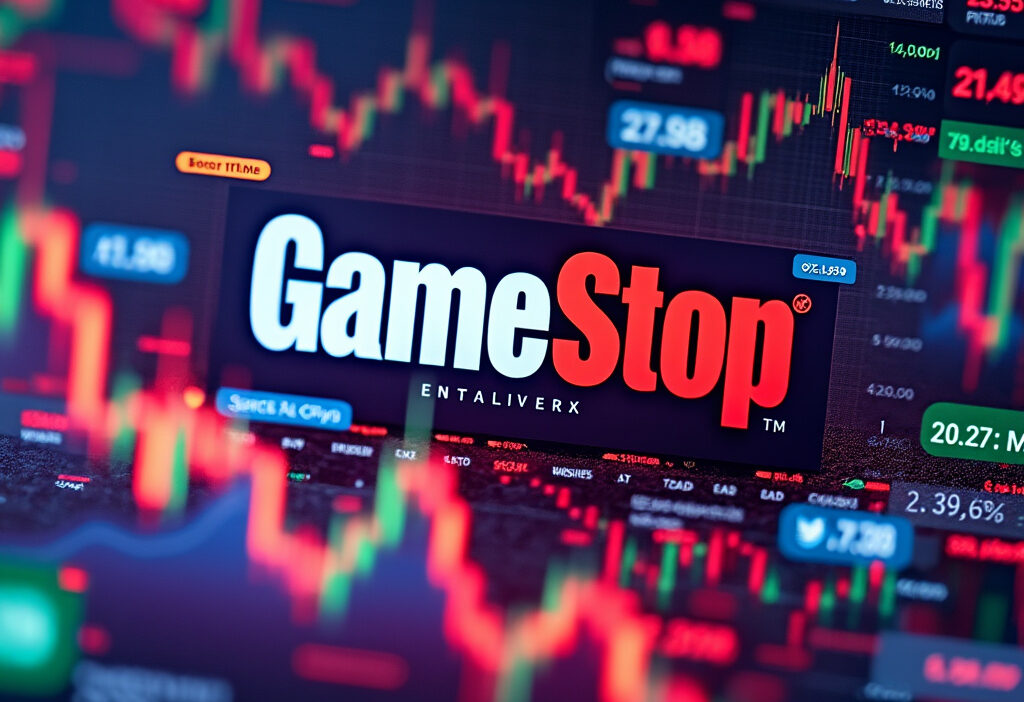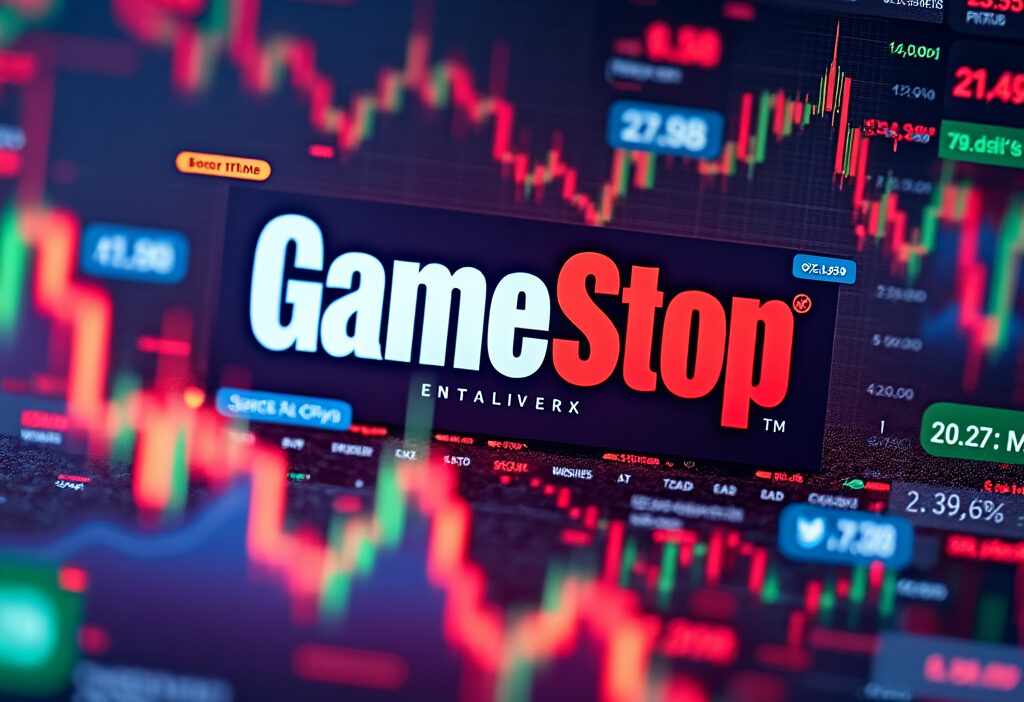GameStop Stock Surge A Deep Dive into the 2025 Rally
The GameStop (GME) stock has once again captured the market’s attention with a significant surge in May 2025. This article delves into the recent performance, historical context, and the driving forces behind this volatility. We also explore expert opinions and future projections to provide a comprehensive understanding of what lies ahead for GME investors.
Recent Performance of GameStop Stock
GameStop (GME) stock surged 10.02% on May 22, 2025, climbing from $28.05 to $30.86, reigniting discussions around its volatility. This rally, while significant, pales in comparison to the 134% spike on January 27, 2025, underscoring GME’s erratic trading patterns. Recent data shows heightened activity, with volume spiking 47% above its 30-day average, suggesting renewed retail interest. Analysts attribute the May surge to a mix of short-covering and speculative momentum, echoing past rallies but with less intensity. The stock’s beta remains elevated at 3.2, reflecting its sensitivity to market sentiment. Compared to 2021’s short squeeze, current moves lack the same frenzy but retain the hallmarks of a meme stock: rapid swings and unpredictable liquidity. Technical indicators like the RSI briefly hit 68, nearing overbought territory, yet failed to trigger a sustained pullback. This resilience hints at a shifting dynamic—where GME’s volatility is no longer solely driven by Reddit hype but also by evolving fundamentals, such as the company’s digital pivot. However, the stock remains a high-risk bet, with intraday swings often exceeding 5%, a reminder of its speculative nature.
Historical Context of GME’s Volatility
GameStop’s volatility is deeply rooted in its history, particularly the 2021 short squeeze that turned it into a meme stock icon. Driven by retail investors coordinating on Reddit, GME surged over 1,500% in weeks, crushing hedge funds betting against it. This event redefined market dynamics, proving the power of collective retail action. Fast forward to January 2025, another explosive rally saw GME spike 134%, reigniting debates about its speculative nature. These surges weren’t just about fundamentals—they reflected a clash between traditional short sellers and a new wave of investor activism. The stock’s wild swings have cemented its reputation as a battleground for market sentiment, where hype and short interest collide. While some see GME as overvalued, others view it as a symbol of defiance against Wall Street. Its volatility isn’t accidental—it’s a product of its unique place in financial history.
Retail Investor Activity and Its Impact
The resurgence of GameStop’s stock in 2025 has once again spotlighted the power of retail investors, echoing the historic 2021 rally. Online communities, particularly on Reddit’s WallStreetBets, have played a pivotal role in orchestrating coordinated buying campaigns, amplifying GME’s volatility. These platforms enable retail traders to share strategies, amplify sentiment, and challenge institutional dominance, turning meme stocks into battlegrounds between Wall Street and Main Street.
The 2025 surge saw retail investors leveraging social media and zero-commission trading apps to execute high-volume trades, squeezing short sellers and defying traditional market logic. Unlike institutional players, these traders often prioritize momentum and collective action over fundamentals, creating unpredictable price swings. The gamification of investing—fueled by apps like Robinhood—further emboldens this behavior, blurring the lines between trading and speculation.
However, this dynamic isn’t without risks. Regulatory scrutiny has intensified, with authorities examining potential market manipulation and the ethical implications of viral trading. Yet, the 2025 rally proves that retail investors remain a disruptive force, reshaping market dynamics and forcing Wall Street to adapt. Their influence underscores a broader shift in financial markets, where accessibility and community-driven strategies can upend conventional wisdom.
The Short Squeeze Phenomenon
A short squeeze occurs when a heavily shorted stock surges in price, forcing short sellers to cover their positions by buying shares, which further drives up the price. GameStop’s 2025 rally, like its 2021 surge, was fueled by this mechanism. High short interest—over 40% of GME’s float at one point—created a tinderbox. When retail investors, as discussed earlier, coordinated buying via platforms like Reddit, the rapid price spike triggered panic among short sellers.
Historical examples include Volkswagen’s 2008 squeeze, where Porsche’s stake revelation caused a 400% surge, and AMC’s 2021 rally. Short interest data is critical: when a stock’s short interest ratio (days to cover) is high, even modest buying can ignite a squeeze. In GME’s case, the combination of high short interest, viral social media campaigns, and limited float made it a perfect storm.
Market behavior around short squeezes often defies fundamentals, as seen with GME’s detachment from traditional valuation metrics. While short squeezes can deliver explosive gains, they also heighten volatility, leaving late entrants vulnerable to sharp reversals. This dynamic sets the stage for the next chapter, where we explore how social media amplifies these movements.
Social Media Influence on GME
Social media has played a pivotal role in GameStop’s stock volatility, particularly through platforms like Reddit’s WallStreetBets (WSB). Retail investors, often dismissed as “dumb money,” leveraged these forums to coordinate buying pressure, countering institutional short sellers. The crowd-driven momentum amplified GME’s surge, turning it into a symbol of retail defiance against Wall Street.
WSB’s influence stems from its ability to rapidly disseminate sentiment, memes, and DD (due diligence) posts, creating a feedback loop of hype. Viral phrases like “YOLO” and “diamond hands” galvanized traders to hold positions despite extreme volatility. Unlike traditional market analysis, this movement prioritized collective action over fundamentals, disrupting conventional price discovery.
Platforms like Twitter and Discord further accelerated the rally, with influencers and streamers amplifying the narrative. The 2025 surge saw renewed activity, as nostalgic retail traders and new participants reignited the battle. However, this dynamic also raises questions about market manipulation risks and the long-term sustainability of social media-driven rallies. While regulators scrutinize these forums, their impact on GME remains undeniable.
Market Sentiment and External Factors
Market sentiment and macroeconomic conditions have played a crucial role in GameStop’s 2025 rally. With interest rates stabilizing after years of volatility, retail investors have regained confidence in high-risk, high-reward assets like GME. Economic indicators, such as easing inflation and strong consumer spending, have fueled speculative trading, while sector-wide trends in retail and technology have amplified interest. The broader market’s shift toward meme stocks—driven by liquidity and FOMO—has further propelled GameStop’s surge. Additionally, short interest fluctuations and institutional positioning reflect evolving sentiment, reinforcing GME’s volatility. External catalysts, including regulatory shifts and sector rotations, continue to shape its trajectory.
Expert Opinions on GME’s Future
Analysts remain sharply divided on GameStop’s (GME) future. Bullish forecasts, like those from Gov Capital, project a potential climb to $50+ by 2026, citing meme stock momentum and short-squeeze potential. Bearish voices, including Wallet Investor, warn of overvaluation, with targets as low as $10, pointing to declining brick-and-mortar sales and digital disruption. Trading Economics offers a neutral outlook, suggesting GME could stabilize near $25 if the company pivots successfully to e-commerce. The debate hinges on whether GameStop can transform its business model fast enough to justify its volatile price action.
GameStop’s Business Challenges
GameStop’s business challenges remain a critical factor in its long-term viability, despite the stock’s volatile surges. The gaming industry’s rapid shift toward digital distribution threatens GameStop’s core brick-and-mortar model, as publishers like Sony and Microsoft push direct-to-consumer sales. Physical game sales have declined for years, with digital now accounting for over 90% of the market in some regions.
GameStop has attempted to pivot, expanding into collectibles, PC hardware, and NFTs, but these efforts face stiff competition from established players like Amazon and Best Buy. Its e-commerce growth, while improving, still lags behind industry leaders. Additionally, high operating costs from its retail footprint weigh on profitability.
Analysts question whether GameStop can sustain its turnaround without a clear differentiator. While cost-cutting and strategic partnerships (like with Microsoft) offer short-term relief, the company must prove it can adapt to an increasingly digital ecosystem. If it fails, the stock’s long-term performance may hinge more on speculative trading than fundamentals.
Comparing GME to Other Meme Stocks
GameStop’s 2025 rally shares striking parallels with other meme stocks like AMC and BlackBerry, yet key differences set GME apart. Like AMC, GameStop benefited from retail investor enthusiasm, fueled by social media buzz and short squeeze dynamics. Both stocks saw extreme volatility, with rapid price surges followed by sharp corrections. However, while AMC’s rally was tied to pandemic recovery hopes, GME’s momentum stemmed from its transformation efforts, including e-commerce expansion and NFT ventures.
BlackBerry, another meme favorite, lacked the same retail frenzy but mirrored GME’s speculative appeal. Unlike GameStop, BlackBerry’s surge was driven by its pivot to cybersecurity and IoT, attracting a different investor base. All three stocks faced skepticism from traditional analysts, yet GME’s cult-like following proved more resilient.
The biggest divergence lies in investor behavior. GameStop’s community, led by figures like Roaring Kitty, remained deeply engaged, while AMC and BlackBerry rallies faded faster. GME’s volatility also reflected higher short interest, making it a recurring battleground for retail vs. institutional traders. These dynamics suggest that while meme stocks share superficial traits, GameStop’s unique narrative and loyal base keep it at the center of the meme stock phenomenon.
Investment Strategies for GME
Investing in GameStop (GME) requires a disciplined approach due to its inherent volatility. Here are key strategies to consider:
Risk Management: Allocate only a small portion of your portfolio to GME, as meme stocks can swing dramatically. Use stop-loss orders to limit downside risk.
Timing: GME often moves in waves fueled by social sentiment. Monitor forums like Reddit and X (Twitter) for shifts in retail investor enthusiasm, but avoid FOMO-driven decisions.
Stay Informed: Track earnings reports, short interest data, and analyst upgrades/downgrades. Unlike traditional stocks, GME’s fundamentals may not always align with price action, so technical analysis can be useful.
Remember, while GME offers high-reward potential, it carries equally high risk. Balance speculation with a long-term, diversified strategy.

Conclusions
The GameStop stock surge in May 2025 is a continuation of its volatile history, driven by retail investor activity, short squeezes, and social media influence. While the short-term outlook shows potential for gains, long-term projections remain cautious due to fundamental business challenges. Investors should weigh these factors carefully before making decisions.



